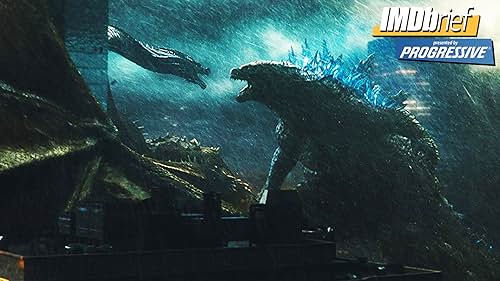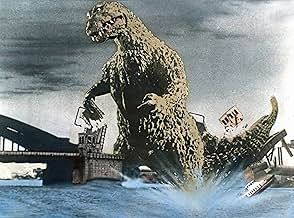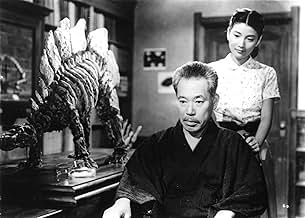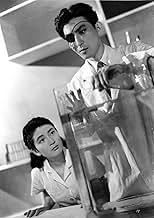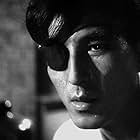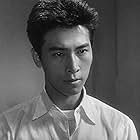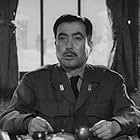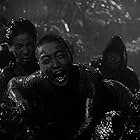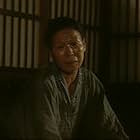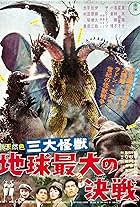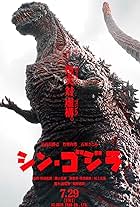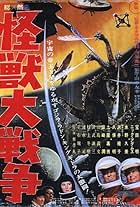After a dinosaur-like beast - awoken from undersea hibernation by atom bomb testing - ravages Tokyo, a scientist must decide if his similarly dangerous weapon should be used to destroy it.After a dinosaur-like beast - awoken from undersea hibernation by atom bomb testing - ravages Tokyo, a scientist must decide if his similarly dangerous weapon should be used to destroy it.After a dinosaur-like beast - awoken from undersea hibernation by atom bomb testing - ravages Tokyo, a scientist must decide if his similarly dangerous weapon should be used to destroy it.
- Awards
- 4 wins & 2 nominations
- The Old Fisherman
- (as Kuninori Kôdô)
Storyline
Did you know
- TriviaAn often-repeated myth is that the productions of both this film and Seven Samurai (1954) nearly drove Toho into bankruptcy. This neglects to mention a third Toho film made that year, Samurai I: Musashi Miyamoto (1954). All three of them were the most expensive Japanese films made up to that point and big financial risks for Toho. However, there is little evidence to suggest that Toho was ever at risk for bankruptcy. Toho released a total of 68 feature films that year, the most successful of which were "Seven Samurai", "Samurai I: Musashi Miyamoto", and "Godzilla", in that order.
- GoofsSeveral characters in the film, including Dr. Yamane, Japan's leading paleontologist, insist that the Jurassic Period was 2 million years ago. This is off by 143.5 million years.
- Quotes
[last lines]
Dr. Kyohei Yamane: I can't believe that Godzilla was the last of his species. If nuclear testing continues, then someday, somewhere in the world, another Godzilla may appear.
- Alternate versionsIn the scene where Godzilla destroys the train, shots of terrified people watching were cut from the U.S. version of the film.
- ConnectionsEdited into Godzilla Raids Again (1955)
- SoundtracksPrayer for Peace
(uncredited)
Performed by students of the Toho High School of Music
Lyrics by Shigeru Kayama
Composed by Akira Ifukube
Japan was best fit to make a film about the effects of nuclear radiation since they had experience the atomic bomb first hand nearly a decade earlier. It was a powerful statement for the time. I really wish more people would give this movie a chance and realize how smart it is.
Besides the powerful message, the film is best known for its pioneering special effects. Yes, by today's standards, the suits and miniatures are pretty archaic. But they still look great over sixty years later. The destruction that Godzilla causes is both exciting and horrifying. Few monster movies have the emotion and smarts that this one has. Of course, their is the monster himself. What a sight. The design has changed greatly over the years but this one is the most iconic of course. The menacing eyes, roar and towering size make him a sight to behold. I highly recommend checking out the behind the scenes features that talk about the making of the famous suit, it's really interesting.
Then there's the most underrated part of the movie, the cast. Most Godzilla fans will recognize Akira Takarada as the lead. He's very good here and would continue to Star in the series for many years. The biggest name here is Takashi Shimura. He's of course best known for appearing in several Akira Kurosawa classics such as Seven Samurai and Ikiru.
Godzilla gets a bad rep because of some mediocre to atrocious sequels with some gems here and there. But the original stands above them like a atomic breath breathing monster. Godzilla is essential cinema that can be enjoyed for many different reasons.
- caseyt-48511
- Aug 5, 2019
- Permalink
Details
- Release date
- Country of origin
- Languages
- Also known as
- Japón bajo el terror del monstruo
- Filming locations
- Production company
- See more company credits at IMDbPro
Box office
- Budget
- $175,000 (estimated)
- Gross US & Canada
- $562,711
- Opening weekend US & Canada
- $38,030
- May 9, 2004
- Gross worldwide
- $588,933
- Runtime1 hour 36 minutes
- Color
- Aspect ratio
- 1.37 : 1
Contribute to this page





